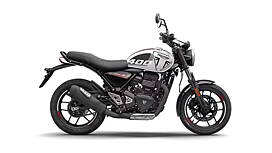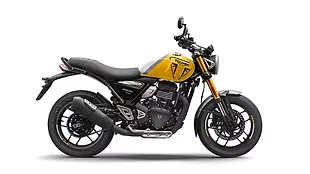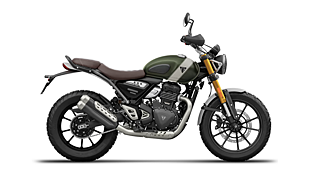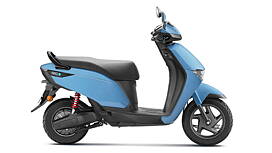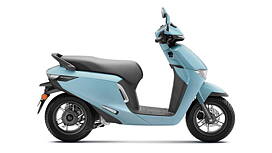Introduction

The beauty of platform sharing lies in the fact that with only a few tweaks, you can build two motorcycles that share a lot in common and are still very different. The Triumph Speed T4 is based on the Speed 400 but there are significant differences between the two. Not only in their appearance but also in the way they ride. The Triumph Speed T4 is tasked with bringing in riders who want a rather chilled-out motorcycle. More importantly, it is a bike that can take on the best sellers in the segment. Because that’s where the size of the pie is the largest. Can the Speed T4 hold a candle to said competition?
The Visuals

The Triumph Speed 400 is a great base to begin with because it is a very good-looking motorcycle. The Speed T4 gets the same modern-classic design as the ‘400’, be it in the round LED headlight, the neatly shaped fuel tank, the side panels or the stubby rear fender.
Where it does distinguish itself from the Speed 400 is in the deeper colours and the lavish use of decals all around. I, however, feel that the bike has one sticker too many, given the design of the bike. But, it is a subjective matter and not a deal breaker as such.

Other visual differences between the two bikes include a steel bracket for the headlight holder instead of an aluminium bracket on the Speed 400, a steel hydroformed handlebar on the T4 instead of an aluminium handlebar and that’s the same case with the footpegs as well.
One gripe that I have with Triumph is their decision to add a blacked-out exhaust pipe. While they claim it is heat resistant, it will be difficult to maintain in our mucky, slushy rains.
On the whole, the Triumph Speed T4 looks good and more importantly, the quality of the paint as well as the fit and finish is what we’d come to expect from Triumph.
The Package

The Speed T4 has the same 398cc, liquid-cooled, single-cylinder engine as in the Speed 400. However, many changes have been made to the internals as well as the final drive to give it a different character. The Speed T4’s engine makes 30.6bhp at 7,000rpm which is lower than the Speed’s. The peak torque at 36Nm arrives significantly lower at 5,000rpm vs the 6,500rpm. In fact, 85 per cent of this torque is available from 2.500rpm only. The torque curve is also meatier between 3,500 and 5,500rpm.
This engine also has a 31 per cent higher crank inertia than the Speed 400’s, which means it is not as quick-revving as the latter’s engine. Triumph has also reduced the rear sprocket size to 39 teeth from the Speed's 43 teeth. All of these changes come together to offer a markedly different riding experience.

The Speed T4 also gets a new telescopic fork and monoshock with 10mm less travel than the first-generation Speed 400. Also, to keep costs in check, the T4 has axial brake calipers with organic brake pads and does away with an electronic throttle body which means there is no traction control as well.
With so many changes, we were quite eager to see what the T4 was like to ride and I have to say, the experience was very interesting.
The Ride

The setting for this brief ride with the Speed T4 was Pune city’s chaotic environment as well as a short but swift ride down a relatively open highway. There could not have been a better test of the engine’s tractability and it genuinely impressed. I could ride as lazily as I wanted and the engine didn’t complain. 20kmph in third gear in the city is possible, with no need to downshift to make a lunge for that gap in traffic. For those of you who hate shifting gears too often, this will come across as music to your ears.
We did sample the Triumph Speed 400 before we hopped on the Speed T4. So the reference marker in the mind was set as we went about riding the latter. I, for one, appreciated this character in the engine, picturing a scenario where you’ve had a long day at work and want to get back home on a motorcycle that requires less effort.

The fat wave of torque is quite apparent on the highway as well. You can stick the gearbox in sixth and sit between 60kmph and 120kmph with barely any need to downshift to make quick overtakes.
All said, what made me like this engine even more is that, unlike the competition, it does not feel out of breath after 100kmph. There is enough top-end performance to sit at triple-digit highway speeds comfortably. And, its low-speed tractability has not come at the expense of a busy and strained top end.
I, hence, see no issues in the Speed T4 catering to the demands of city commutes and highway touring as long as you want to sit at speeds up to 120kmph. Beyond this, the performance begins to taper until you hit a speedo-indicated 140kmph.
Also, the engine feels buzzy under hard, in-gear acceleration. However, at cruising speeds of 80-110kmph, the vibrations are well within control as the revs are not high.

As for the ride and handling, it is quite good for the most part. The few bumps and potholes that I encountered did little to unsettle the bike or throw me off the seat. That said, the suspension does have a slightly firm edge to it but I’ll wait for a comprehensive test over Mumbai’s potholed roads to give out a conclusive judgement about the ride.
The handling, however, is planted and predictable around corners. Despite the small increase in the wheelbase, the Speed T4 continues to feel light-footed while changing direction. As for the feel and feedback from the MRF bias-plys, it is quite good for the speeds and the road conditions I encountered.
The one area that could be improved is the brakes. While they are pretty good in most braking scenarios, under emergency stopping scenarios, the brake lever travel was a lot more than I’d anticipated.
Should You Buy It?

With a price tag of Rs 2.17 lakh, the Triumph Speed T4 slots in between two of its chief rivals, the Royal Enfield Hunter 350 and the Hero Mavrick 440. What it brings to the table is a good, tractable engine with enough punch at the top. The ride is comfortable and the handling is good as well. Even the feature list is par for the course, except the lack of Bluetooth connectivity on the instrument cluster.
That little omission aside, the Speed T4 comes across as formidable competition to the aforementioned motorcycles. Triumph is surely going to take a slice off this big pie. To me, however, the engine’s characteristics suits the modern-classic appearance of the Speed T4 far better than the Speed 400. And if this is the kind of easy-to-ride motorcycle that you are looking for, the Triumph Speed T4 should figure on your shopping list.
Photography by Kapil Angane
Gallery
1/30
Triumph Speed T4 Front Disc Brake
Double Tap to Zoom
















